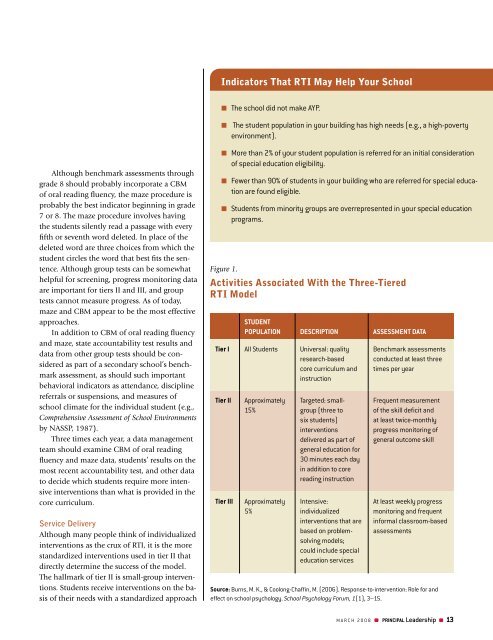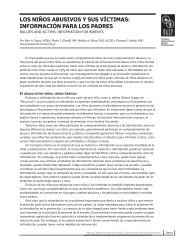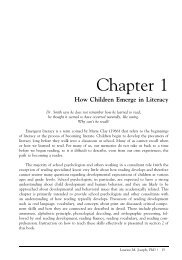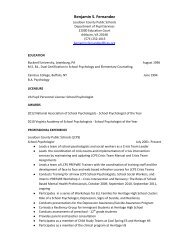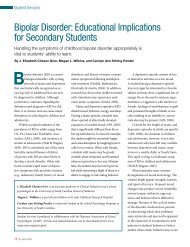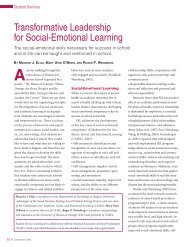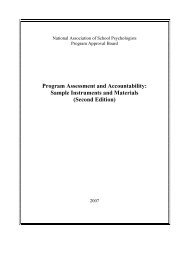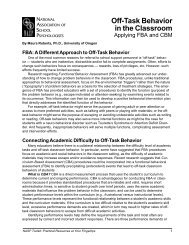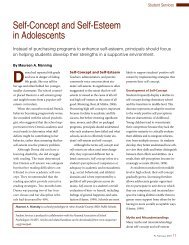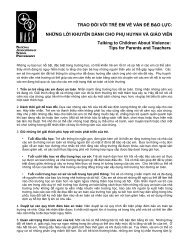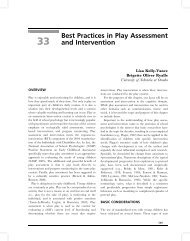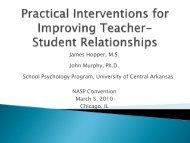Response to Intervention: The Future for Secondary Schools
Response to Intervention: The Future for Secondary Schools
Response to Intervention: The Future for Secondary Schools
You also want an ePaper? Increase the reach of your titles
YUMPU automatically turns print PDFs into web optimized ePapers that Google loves.
Although benchmark assessments through<br />
grade 8 should probably incorporate a CBM<br />
of oral reading fuency, the maze procedure is<br />
probably the best indica<strong>to</strong>r beginning in grade<br />
7 or 8. <strong>The</strong> maze procedure involves having<br />
the students silently read a passage with every<br />
ffth or seventh word deleted. In place of the<br />
deleted word are three choices from which the<br />
student circles the word that best fts the sentence.<br />
Although group tests can be somewhat<br />
helpful <strong>for</strong> screening, progress moni<strong>to</strong>ring data<br />
are important <strong>for</strong> tiers II and III, and group<br />
tests cannot measure progress. As of <strong>to</strong>day,<br />
maze and CBM appear <strong>to</strong> be the most effective<br />
approaches.<br />
In addition <strong>to</strong> CBM of oral reading fuency<br />
and maze, state accountability test results and<br />
data from other group tests should be considered<br />
as part of a secondary school’s benchmark<br />
assessment, as should such important<br />
behavioral indica<strong>to</strong>rs as attendance, discipline<br />
referrals or suspensions, and measures of<br />
school climate <strong>for</strong> the individual student (e.g.,<br />
Comprehensive Assessment of School Environments<br />
by NASSP, 1987).<br />
Three times each year, a data management<br />
team should examine CBM of oral reading<br />
fuency and maze data, students’ results on the<br />
most recent accountability test, and other data<br />
<strong>to</strong> decide which students require more intensive<br />
interventions than what is provided in the<br />
core curriculum.<br />
service delivery<br />
Although many people think of individualized<br />
interventions as the crux of RTI, it is the more<br />
standardized interventions used in tier II that<br />
directly determine the success of the model.<br />
<strong>The</strong> hallmark of tier II is small-group interventions.<br />
Students receive interventions on the basis<br />
of their needs with a standardized approach<br />
Indica<strong>to</strong>rs that rtI may Help Your school<br />
n <strong>The</strong> school did not make aYP.<br />
n <strong>The</strong> student population in your building has high needs (e.g., a high-poverty<br />
environment).<br />
n More than 2% of your student population is referred <strong>for</strong> an initial consideration<br />
of special education eligibility.<br />
n Fewer than 90% of students in your building who are referred <strong>for</strong> special education<br />
are found eligible.<br />
n Students from minority groups are overrepresented in your special education<br />
programs.<br />
Figure 1.<br />
activities associated With the three-tiered<br />
rtI model<br />
STUDEnT<br />
POPUlaTiOn DEScriPTiOn aSSESSMEnT DaTa<br />
Tier i all Students Universal: quality<br />
research-based<br />
core curriculum and<br />
instruction<br />
Tier ii approximately<br />
15%<br />
Tier iii approximately<br />
5%<br />
Targeted: smallgroup<br />
(three <strong>to</strong><br />
six students)<br />
interventions<br />
delivered as part of<br />
general education <strong>for</strong><br />
30 minutes each day<br />
in addition <strong>to</strong> core<br />
reading instruction<br />
Intensive:<br />
individualized<br />
interventions that are<br />
based on problemsolving<br />
models;<br />
could include special<br />
education services<br />
Benchmark assessments<br />
conducted at least three<br />
times per year<br />
Frequent measurement<br />
of the skill defcit and<br />
at least twice-monthly<br />
progress moni<strong>to</strong>ring of<br />
general outcome skill<br />
at least weekly progress<br />
moni<strong>to</strong>ring and frequent<br />
in<strong>for</strong>mal classroom-based<br />
assessments<br />
Source: Burns, M. K., & coolong-chaffn, M. (2006). response-<strong>to</strong>-intervention: role <strong>for</strong> and<br />
effect on school psychology. School Psychology Forum, 1(1), 3–15.<br />
March 2008 PrinciPal Leadership 13


